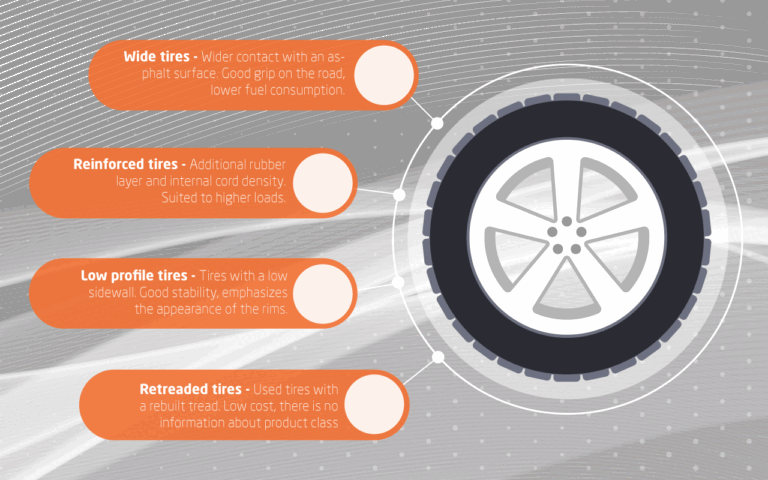Types and kinds of car tires
Various purposes, different weather conditions, as well as the changing type of road, require the use of several types of car tires. Adapting the tire to driving conditions is not only an element of comfort but above all the basic safety parameter. The various types of car tires on the market can be confusing, so now we will discuss the most important of them.

When buying new tires you need to remember that the wheels are the only element of our car that has constant contact with the surface. Therefore, before we started to prepare the list of common tires, we have asked Mateusz Bieda, who works at Aircom as a Test Engineer, how is he preparing to replace tires in his car:
Wide tires
Wide tires are used primarily in cars with low suspension. The greater the width of the rubber, the better grip you will receive, which is especially important when cornering. However, the stick always has two ends – the grip of wide rubber to the surface is associated with significant rolling resistance, which translates into a noticeable increase in fuel demand. When choosing a wide tire, you should also consider the braking properties. The wider contact surface with the asphalt helps to stop the vehicle quickly, which is why wide tires are a permanent part of the equipment of sports cars that develop high speeds.
Reinforced tires
Reinforced tires, usually marked as XL, can take higher loads. The load index should be matched to the vehicle make and total weight, but also the road conditions. Traveling regularly on gravel surfaces, as well as carrying a lot of cargo, make a reinforced tire the perfect choice for any vehicle. Reinforced tires have the same tread pattern as any other tire. The only difference is that there is an additional layer of rubber in the side structure with a different density of internal cords.
Low profile tires
The low sidewall is a characteristic feature of low-profile tires that emphasize the dynamic character of the vehicle. Tires of this type also bring additional driving characteristics, such as greater control of the vehicle when steering the steering wheel, as well as additional stability resulting from low susceptibility to lateral tilt.

Summer and winter tires
Summer and winter tires are the most sought-after product for most drivers. Summer tires are perfect for temperatures above 6 degrees Celsius. Winter tires, on the other hand, are made of a different type of rubber that does not harden even at -20 degrees Celsius. The design of the tread itself allows better attachment to the ground covered with snow or ice. Winter tires should not be used in summer. The quickly wearing out tread is not the only cause. A winter tire has a slower braking distance and is more susceptible to aquaplaning.
All-season tires
For people who value comfort, an interesting alternative is all-season tires offered by all manufacturers. Modern technologies of rubber production allow adjusting its properties to the average weather conditions. It is not true that all-season tires differ in quality from other types of car tires. Tests show that the best quality all-season tires are perfect for various climatic conditions.
Retreaded tires
It becomes possible to reduce the purchase cost of four car tires by choosing the so-called retreaded tires. The sidewall structure of such a tire remains a used component, and a new outer layer of rubber is applied to the worn tread. The purchase of retreaded tires is associated with low purchase costs but does not provide the same durability as new tires. In the case of retreaded tires, however, the most important thing is grip and a low price, and the effectiveness of these parameters cannot be denied. Retreaded tires are a common element of savings on the largest diameter tires intended for trucks.
Nordic tires
Among the special-purpose tires, there are the so-called Nordic tires, the main goal of which is to ensure maximum grip on snow and ice. Extreme weather conditions in Scandinavian countries require the use of intermediate solutions between winter tires and snow spikes.
Thus, different types of car tires have different purposes. It is worth choosing solutions adapted to individual use, bearing in mind the issues of safety and good driving characteristics. The selection is facilitated by various tire rankings, showing their behavior under various test conditions.






